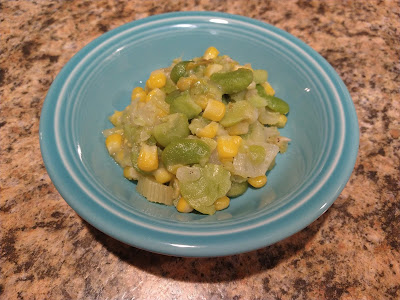
Recipe: Fava bean succotash with fresh corn
 |
| Favas have big pods and beans with chewy skins that are best removed. (Photos: Debbie Arrington) |
Succotash is a true American original. According to culinary lore, Native Americans introduced colonists to this mix of corn and beans – two crops that they grew (usually together). The name comes from an Algonquian word for “boiled corn kernels.”
In the late 1700s, New England recipes described succotash as “boiled corn and green beans especially limas.” Other vegetables were added to the flavorful mix and different beans substituted. Succotash evolved along with our country.
Favas work well as a substitute for limas, but these brightly colored (and meaty) beans cook in a fraction of the time. Although the peeled fava beans cook quickly, they take a while to prepare. After removal from their pods, large mature beans need to be individually skinned.
Those skins tend to be tough, chewy and bitter. Removal improves favas’ overall flavor and texture. Small, tender immature beans (under ¼ inch) can keep their skins on.
How to skin fava beans: Remove beans from pods. Bring a large pot of salted water to a boil. Plunge beans into boiling water and boil for 3 to 4 minutes, until the skins start to wrinkle.
Drain; plunge beans into ice water or rinse under cold water. With a thumb nail or paring knife, make a slit on long side of each bean and peel off skin, one at a time. Set aside the bright green fava beans.
Two cups unshelled fava beans yields about 1 to 1-1/4 cups peeled.
Fava beans also may be frozen for later use.
Fava bean succotash
Makes 4 servings
Ingredients:
1 cup fava beans, peeled
2 tablespoons butter
½ cup onions, chopped
½ cup celery, chopped including green tops
1 cup fresh corn kernels, cut from the cob
½ cup water
Salt and pepper to taste
Instructions:
Peel fava beans and set side.
In a heavy saucepan, melt butter. Saute onion and celery until soft.
Add corn kernels and water; bring to boil, then reduce heat to medium. Cover. Cook 4 minutes, until corn is almost tender.
Stir in fava beans gently. Add a little more water if necessary. Cover and cook over medium heat for 4 or 5 minutes, until beans are tender but not mushy.
Season with salt and pepper to taste. Serve immediately.
 |
| Fava bean succotash features fresh favas and corn. |
Comments
0 comments have been posted.Sacramento Digs Gardening to your inbox.
Sites We Like
Garden Checklist for week of July 21
Your garden needs you!
* Keep your vegetable garden watered, mulched and weeded. Water before 8 a.m. to reduce the chance of fungal infection and to conserve moisture.
* Feed vegetable plants bone meal, rock phosphate or other fertilizers high in phosphate to stimulate more blooms and fruiting. (But wait until daily high temperatures drop out of the 100s.)
* Don’t let tomatoes wilt or dry out completely. Give tomatoes a deep watering two to three times a week.
* Harvest vegetables promptly to encourage plants to produce more. Squash especially tends to grow rapidly in hot weather. Keep an eye on zucchini.
* Pinch back chrysanthemums for bushy plants and more flowers in September.
* Remove spent flowers from roses, daylilies and other bloomers as they finish flowering.
* Pinch off blooms from basil so the plant will grow more leaves.
* Cut back lavender after flowering to promote a second bloom.
* It's not too late to add a splash of color. Plant petunias, snapdragons, zinnias and marigolds.
* From seed, plant corn, pumpkins, radishes, winter squash and sunflowers.